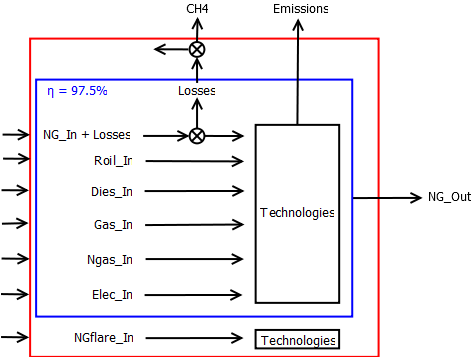3: Difference between revisions
(→Model) |
(→Model) |
||
| Line 8: | Line 8: | ||
This process is modeled using shared inputs and two static amounts. Those were deducted from the Excel spreadsheet calculations.<br> | This process is modeled using shared inputs and two static amounts. Those were deducted from the Excel spreadsheet calculations.<br> | ||
[[File:3_model.png]] | [[File:3_model.png]] | ||
As it can be seen from the model the losses are accounted into the global efficiency of the process, but the Flared Natural Gas isn't. This is modeled the same way in Excel except that an "fake" Natural Gas input is added to the line "Feed Loss" in order to model the losses. | |||
In our case we just add that to the main input. | |||
==Calculations== | |||
Revision as of 17:45, February 24, 2012
NA NG Recovery
NA NG Recovery is calculated using an efficiency and fuel shares, basically we calculate how much input is necessary to the process and assign that to each input using the shares, except for what is considered to be the main input. The main input is defined by an amount of 1mmBtu + losses. Here we do not need any Feed Loss or Loss Factor as we define the inputs and output for all our processes. As the inputs and output are not fulls described in the Excel version, they need the loss factors and feed loss, but we decided to get rid of them in order to gain in simplicity for the users.
Model
This process is modeled using shared inputs and two static amounts. Those were deducted from the Excel spreadsheet calculations.

As it can be seen from the model the losses are accounted into the global efficiency of the process, but the Flared Natural Gas isn't. This is modeled the same way in Excel except that an "fake" Natural Gas input is added to the line "Feed Loss" in order to model the losses. In our case we just add that to the main input.